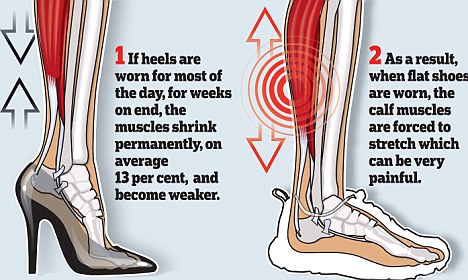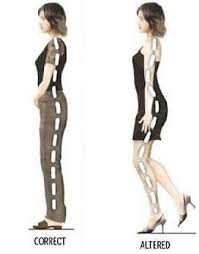Let’s be honest, high heels are pretty and they make our legs look longer… It’s unfortunate because, if it weren’t for this fact, we would probably never ever wear them! But are they really that bad for you?
Well, yes …they are…
There is no point in sugar-coating this but (just like sugar!) you should avoid heels in excessive amounts.
What do high heels do to your feet?
Excessive high heel wearing can contribute to:
- plantar fasciitis
- bunions
- ingrown toenails
- calf & achilles pain
When you put your feet in a pair of high heels, your calf muscle and Achilles are placed in a shortened position.
Not only is it harder for your calf muscles to generate strength in a shortened position, but the muscle can also lose the ability to lengthen enough to comfortably get your heel to floor. This is why many women say “wearing high heels is actually more comfortable than going barefoot”!
In addition to this, high heels cause your forefoot to be squished and your toes are often squeezed into a narrow, pointed toe box. This means that the small muscles of the feet, which play an important role in keeping you balanced and your arches supported, are not able to work efficiently.
What do high heels do to the rest of your body?
Wearing high heels causes your centre of gravity to be shifted forward (which is one of the reasons they can be so hard to walk in!)
When this happens, your standing posture changes. Most notably, you usually have an increase in your lumbar lordosis (lower back curve).
This can be aggravating for some and can contribute to things like:
- back pain
- hip pain
- pelvic joint pain
- venous problems (like varicose veins)
- muscle cramps
So how often should heels be worn?
This will be different for everyone. If you experience any pain whilst wearing high heels or very soon after, you should probably avoid wearing them completely.
If you do not notice any ill-effects with wearing high heels, you should still aim to wear them for less than 50% of the total time you spend in standing.
How can you minimise the damage caused by wearing heels?
- Do regular calf stretches
Check out this ‘Calf stretch program‘ for more detailed information.
- Reduce the height of your heels and opt for a chunkier heel
This will reduce the shortening of the calf muscle and help distribute the load more evenly.
- Alternate your shoe choice throughout the day or from one day to the next
GLOW Physio can do a full biomechanical assessment of your feet and posture and treat using manual therapy, massage, dry needling and taping to help manage any niggles that arise from wearing heels!
Recommended reading from Glow
Which pillow should I choose?
5 habits for a happy, healthy spine!
5 simple exercises to kick-start your day!
5 Tips for Improving Driving Comfort


